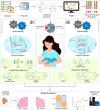Machine Learning Models for Prediction of Xenobiotic Chemicals with High Propensity to Transfer into Human Milk
- PMID: 38524439
- PMCID: PMC10955560
- DOI: 10.1021/acsomega.3c09392
Machine Learning Models for Prediction of Xenobiotic Chemicals with High Propensity to Transfer into Human Milk
Abstract
Breast milk serves as a vital source of essential nutrients for infants. However, human milk contamination via the transfer of environmental chemicals from maternal exposome is a significant concern for infant health. The milk to plasma concentration (M/P) ratio is a critical metric that quantifies the extent to which these chemicals transfer from maternal plasma into breast milk, impacting infant exposure. Machine learning-based predictive toxicology models can be valuable in predicting chemicals with a high propensity to transfer into human milk. To this end, we build such classification- and regression-based models by employing multiple machine learning algorithms and leveraging the largest curated data set, to date, of 375 chemicals with known milk-to-plasma concentration (M/P) ratios. Our support vector machine (SVM)-based classifier outperforms other models in terms of different performance metrics, when evaluated on both (internal) test data and an external test data set. Specifically, the SVM-based classifier on (internal) test data achieved a classification accuracy of 77.33%, a specificity of 84%, a sensitivity of 64%, and an F-score of 65.31%. When evaluated on an external test data set, our SVM-based classifier is found to be generalizable with a sensitivity of 77.78%. While we were able to build highly predictive classification models, our best regression models for predicting the M/P ratio of chemicals could achieve only moderate R2 values on the (internal) test data. As noted in the earlier literature, our study also highlights the challenges in developing accurate regression models for predicting the M/P ratio of xenobiotic chemicals. Overall, this study attests to the immense potential of predictive computational toxicology models in characterizing the myriad of chemicals in the human exposome.
© 2024 The Authors. Published by American Chemical Society.
Conflict of interest statement
The authors declare no competing financial interest.
Figures



Similar articles
-
Assessing chemical exposure risk in breastfeeding infants: An explainable machine learning model for human milk transfer prediction.Ecotoxicol Environ Saf. 2025 Jan 1;289:117707. doi: 10.1016/j.ecoenv.2025.117707. Epub 2025 Jan 11. Ecotoxicol Environ Saf. 2025. PMID: 39799920
-
Prediction of milk/plasma drug concentration (M/P) ratio using support vector machine (SVM) method.Pharm Res. 2006 Jan;23(1):41-8. doi: 10.1007/s11095-005-8716-4. Epub 2006 Nov 30. Pharm Res. 2006. PMID: 16308669
-
Application of a developed triple-classification machine learning model for carcinogenic prediction of hazardous organic chemicals to the US, EU, and WHO based on Chinese database.Ecotoxicol Environ Saf. 2023 Apr 15;255:114806. doi: 10.1016/j.ecoenv.2023.114806. Epub 2023 Mar 20. Ecotoxicol Environ Saf. 2023. PMID: 36948010
-
Prediction model for milk transfer of drugs by primarily evaluating the area under the curve using QSAR/QSPR.Pharm Res. 2023 Mar;40(3):711-719. doi: 10.1007/s11095-023-03477-1. Epub 2023 Jan 31. Pharm Res. 2023. PMID: 36720832 Free PMC article.
-
Environmental Chemicals in Breast Milk and Formula: Exposure and Risk Assessment Implications.Environ Health Perspect. 2018 Sep;126(9):96001. doi: 10.1289/EHP1953. Environ Health Perspect. 2018. PMID: 30187772 Free PMC article. Review.
Cited by
-
Drug Safety During Breastfeeding: A Comparative Analysis of FDA Adverse Event Reports and LactMed®.Pharmaceuticals (Basel). 2024 Dec 9;17(12):1654. doi: 10.3390/ph17121654. Pharmaceuticals (Basel). 2024. PMID: 39770496 Free PMC article.
-
Maternal Lifestyle Factors Affecting Breast Milk Composition and Infant Health: A Systematic Review.Nutrients. 2024 Dec 27;17(1):62. doi: 10.3390/nu17010062. Nutrients. 2024. PMID: 39796495 Free PMC article.
-
Computational approaches for toxicology and Pharmacokinetic properties prediction.J Pharmacokinet Pharmacodyn. 2025 Sep 4;52(5):51. doi: 10.1007/s10928-025-09999-y. J Pharmacokinet Pharmacodyn. 2025. PMID: 40908375 Review.
References
-
- Bartick M. C.; Schwarz E. B.; Green B. D.; Jegier B. J.; Reinhold A. G.; Colaizy T. T.; Bogen D. L.; Schaefer A. J.; Stuebe A. M. Suboptimal Breastfeeding in the United States: Maternal and Pediatric Health Outcomes and Costs. Matern. Child Nutr. 2017, 13 (1), e1236610.1111/mcn.12366. - DOI - PMC - PubMed
LinkOut - more resources
Full Text Sources
Research Materials
